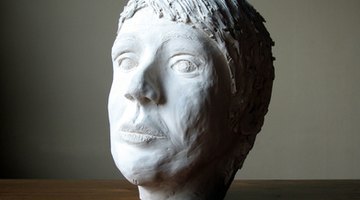Ways to Remove Old Plaster From Wood Surfaces
Cleaning up plaster drips before they dry can save hours in cleaning them after they dry. Plaster can be particularly damaging if it falls on certain surfaces such as wood. Wood is porous and soft, which makes it susceptible to getting scratched if the plaster is scraped off.

Avoid this by softening the plaster before you remove it. This will allow you to use less force when scraping, and will lower the chance of scratching your wood surface.
Hot Water Method
Even old plaster can sometimes dissolve when it is soaked in warm water. To remove old plaster, spray warm water over it and let it sit for several hours until it has softened. Alternatively, place a towel soaked in warm water over the plaster so that it will stay wet for longer. Re-wet or respray the plaster as it dries. Be careful not to soak the wood as this could warp or rot it, especially if the wood surface is unfinished. When the plaster is soft, gently scrape it with a dull putty knife or the back of a metal spoon.
Iron Method
Very stubborn plaster residue may be difficult to soften with just warm water. If this is the case, place a wet rag over the plaster and then place a hot iron over the rag. Begin with medium heat, and then turn up the heat until the plaster softens completely. Use a dull scraper or the back of a metal spoon to scrape the plaster from the wood surface. Wear welding or oven gloves to protect your hands from the steam that will rise from the wet rag.
Sanding Method
If neither of these methods work, use fine sandpaper to sand away the old plaster stains. Using fine sandpaper may take longer to remove the plaster, but it will prevent you from accidentally making the deep scratches in your wood surface that medium- or coarse-grit sandpaper can. To use sandpaper, clean and dry the wood surface completely. Gently rub the plaster with the fine sandpaper. Wrap the sandpaper around your finger to prevent it from sanding the wood surface. Only use this method as a last resort, because sanding can ruin finished wood surfaces. However, if you are going to sand your floors anyway, ignore other plaster removal methods, as the plaster will be completely removed when you sand.
The Drip Cap
- Cleaning up plaster drips before they dry can save hours in cleaning them after they dry.
- Avoid this by softening the plaster before you remove it.
- Be careful not to soak the wood as this could warp or rot it, especially if the wood surface is unfinished.
- Very stubborn plaster residue may be difficult to soften with just warm water.
- If this is the case, place a wet rag over the plaster and then place a hot iron over the rag.
References
Writer Bio
Kaye Wagner has been working in the fields of journalism and public relations since 2006 and is a recipient of a National Hearst Award. She is particularly interested in home-and-garden projects, as well as beauty and fashion writing. An avid traveler, she also writes travel reviews and guides. Wagner earned a Bachelor of Arts in journalism from Brigham Young University.
Photo Credits
- Head of plaster image by Pontus Edenberg from Fotolia.com
- Head of plaster image by Pontus Edenberg from Fotolia.com
More Articles



